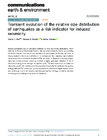Transient evolution of the relative size distribution of earthquakes as a risk indicator for induced seismicity

Open access
Datum
2022-10-25Typ
- Journal Article
Abstract
Induced earthquakes pose a substantial challenge to many geo-energy applications, and in particular to Enhanced Geothermal Systems. We demonstrate that the key factor controlling the seismic hazard is the relative size distribution of earthquakes, the b-value, because it is closely coupled to the stress conditions in the underground. By comparing high resolution observations from an Enhanced Geothermal System project in Basel with a loosely coupled hydro-mechanical-stochastic model, we establish a highly systematic behaviour of the b-value and resulting hazard through the injection cycle. This time evolution is controlled not only by the specific site conditions and the proximity of nearby faults but also by the injection strategy followed. Our results open up new approaches to assess and mitigate seismic hazard and risk through careful site selection and adequate injection strategy, coupled to real-time monitoring and modelling during reservoir stimulation. Mehr anzeigen
Persistenter Link
https://doi.org/10.3929/ethz-b-000578058Publikationsstatus
publishedExterne Links
Zeitschrift / Serie
Communications Earth & EnvironmentBand
Seiten / Artikelnummer
Verlag
SpringerOrganisationseinheit
02818 - Schweiz. Erdbebendienst (SED) / Swiss Seismological Service (SED)
Förderung
691728 - Demonstration of soft stimulation treatments of geothermal reservoirs (SBFI)
821115 - Real-time Earthquake Risk Reduction for Europe (EC)
Zugehörige Publikationen und Daten
Is supplemented by: https://doi.org/10.3929/ethz-b-000567594


